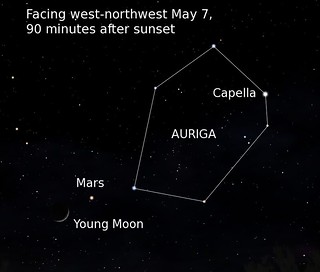Northern Sky: May 11 - 24, 2019
NORTHERN SKY by Deane Morrison May11-24, 2019
Here in mid-May, we have two planets that are fairly bright and busy moving into prime viewing position. Those planets are Jupiter and Saturn, and they’re rising in the southeast earlier every day, but still pretty late. Jupiter makes it up before midnight, but Saturn doesn’t; it follows Jupiter around two hours later. You can also see them in the predawn sky, say 4 to 4:30 a.m. Jupiter is the brightest thing after the moon, and Saturn the next brightest thing to the east of Jupiter.
The planets are about 27 degrees apart, which isn’t very far. Not coincidentally, Earth is getting ready to lap both of them in the race around the sun. Jupiter on June 10, Saturn on July 9. When we lap an outer planet, it’s up all night, which is ideal for viewing. However, summer’s coming, our hemisphere is tilting away from the night sky, and the sun has stolen a big chunk of it. Right now, we can only see Jupiter and/or Saturn very late in the evening or ridiculously early in the morning.
On top of that, between May 11 and 24, the period this broadcast covers, the moon will be big and bright enough to wash out a lot of the stars that form a backdrop for the planets.
Well, if you can’t beat ‘em, join ‘em. Let’s look at what the moon can do for us. The evening of the 11th, it’ll be at first quarter phase. This is a good time to pull out your binoculars or small telescope and have a look at the moon. During quarter phases, the moon is 90 degrees from the sun, and lunar features, like craters, appear in sharp relief. Just east of the moon, you’ll see Regulus, the brightest star in Leo, the lion. Regulus is the dot in a backward question mark of stars called the Sickle, which outlines the lion’s head.
A night or two later, on the 12th or 13th, the moon will have moved farther east in Leo. The lunar features will still stand out, and a famous one will now be lighted. That’s the Tycho crater, which was named after the great Danish astronomer Tycho Brahe, who died in 1601 at age 54. The crater is near the south pole of the moon and is about 53 miles across. It’s remarkable for the long bright lines radiating from it; these are where material was thrown during the collision with whatever space rock came along and gouged out the crater. The crater has been estimated to be about 100 million years old, which is young for a lunar feature.
Between the 15th and 16th of May, the moon passes between Spica, the only reasonably bright star in Virgo, and brilliant Arcturus, in Bootes, the herdsman. Spica will be below the moon, and much closer to it than Arcturus.
May’s full moon rises over Grand Marais at 8:27 on the evening of the 18th. It crosses the night sky above Antares, the red heart of Scorpius. Over the next several days, the waning moon sweeps past Antares, then Jupiter and Saturn.
In the north, the Big Dipper hangs more or less upside down at nightfall. The two stars at the far end of its bowl—that is, farthest from the handle—point down to Polaris, the North Star. Flanking Polaris, but closer to the horizon, are two bright stars. On the left is Capella, in Auriga, the charioteer, and to the right is Vega, the brightest of the Summer Triangle of bright stars. And if you follow the curve of the Big Dipper’s handle, it’ll take you to Arcturus again.
Deane Morrison writes the Minnesota Starwatch column for the U of M’s Minnesota Institute for Astrophysics.
Tweet




